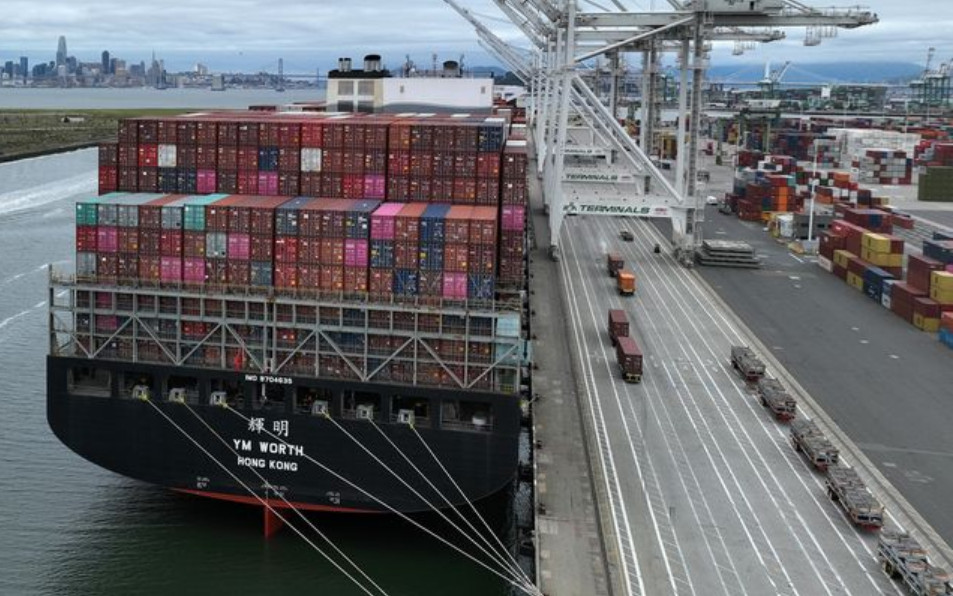Dockworkers and port employers were on their way to a deal, then they hit a wall on wages
U.S. retailers and manufacturers are facing mounting delays at West Coast ports as tensions rise between unionized dockworkers and employers who have been locked in labor talks for more than a year.
Job actions that began early this month have delayed the flow of imports through the ports and led to calls for the Biden administration to intervene to get contract negotiations on track and ensure the country doesn’t see supply-chain disruptions that would hit a fragile U.S. economy.
Here is what the situation at the ports and at the negotiating table look like, and how we got to this point.
How are ports being disrupted?
Dockworkers in key positions have slowed work or not shown up to cargo-handling terminals at ports from California to Washington state since June 2. Shipping officials at Los Angeles and Long Beach, the busiest container complex in the country, say seven ships at the port were behind schedule as of Thursday and up to 28 ships scheduled to arrive over the next week are expected to run late unless dockworkers resume work.

A container ship docked at the Port of Oakland. PHOTO: JUSTIN SULLIVAN/GETTY IMAGES
The labor disruptions have forced some cargo-handling facilities to close morning or afternoon operations or limit the number of cranes that can work to load and unload ships. The Port of Oakland was effectively shut down for a period but has since reopened.
Are we seeing a repeat of the disruptions that choked import flows in the highly contentious talks in 2014 and 2015?
The job actions so far have been targeted and relatively limited. But past contract talks have started out with sporadic disruptions that metastasized into broader disruptions that caused massive backups of container ships. Delays in cargo imports in the last contract cycle in 2014 cost retailers millions of dollars in lost sales and the backups at the ports took months to clear after an agreement was finally reached in 2015.
Why are tensions rising?
Since the talks began in May 2022, negotiators have reached agreements on benefits and the use of automation on the docks, but they hit a wall when they turned to wages the week of May 29.
People familiar with the talks say the International Longshore and Warehouse Union, which represents about 22,000 dockworkers at 29 West Coast ports, initially sought to double their wages over the life of the six-year contract. The two sides have traded proposals on pay this week but they remain far apart. The Pacific Maritime Association, which represents employers and which is dominated by the ocean carriers, says it can’t afford the large increases the dockworkers’ union is seeking for full-time employees that make an average of around $200,000 annually.
Dockworkers believe such raises are justified because the world’s largest ocean carriers, mostly based in Europe and Asia, made tens of billions of dollars in profits during the pandemic while dozens of dockworkers died as they kept cargo flowing through the ports.
Why are carriers reluctant to raise wages?
The carriers expected to award large pay increases, including a more than 10% raise in the first year of the new contract, according to people familiar with the talks. But carriers are wary of locking in much higher labor costs in a boom-and bust industry that appears to be heading into a downturn.
Many shipping lines made enormous profits during the pandemic as heavy demand by Western consumers drove big gains in trade volumes and freight rates in the capacity-strained sector soared. Shipping prices have plummeted over the past year and carrier executives are sounding alarms about the future.
Profits among some of the largest carriers fell 81%, on average, in the first quarter of this year compared with 2022, according to Denmark-based marine data company Sea-Intelligence, though they were still 10 times higher than in 2019. Some shipping industry officials worry raising labor costs at West Coast ports will increase prices and push importers and exporters to more heavily use ports on the Gulf Coast and East Coast.
What happens next?
If the sides can’t reach an agreement soon they may have to call on the Biden administration to intervene, according to people familiar with the talks.
The U.S. Chamber of Commerce on Friday asked the Biden administration to appoint an independent mediator to help the parties reach an agreement before the delays start to affect U.S. supply chains. Business groups representing retailers and manufacturers had earlier called on the White House to intervene.
Shipping industry officials view the administration as unsympathetic. President Biden accused ocean carriers of “ripping off” U.S. importers during the pandemic and called on federal regulators to crack down on high shipping fees.
People familiar with the talks say acting Labor Secretary Julie Su on a recent call with employers suggested ocean carriers should share their profits with workers.
If a mediator can’t guide the two sides to a deal, President Biden can invoke a federal law to force dockworkers to resume normal operations. President George W. Bush was the last president to invoke the Taft-Hartley Act, after port employers locked dockworkers out of the ports for 10 days during highly fractious negotiations in 2002.


